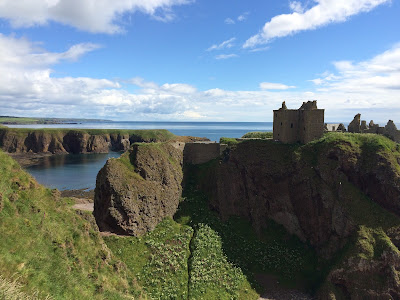Couldn't have picked a nicer morning to visit Dunottar castle just south of Aberdeen. This castle dates back to the 1400 and 1500s, but was a fortified location even before that. It is not quite on an island, but is accessible only by going down a steep hill and up an steep narrow ridge with the castle fortifications directly above you. Highly defensible. The castle is most famous for keeping the Honors of Scotland (royal Scottish jewels and regalia) safe when Cromwell invaded in the 1600s. Before the garrison surrendered (because Cromwell's artillery could level the castle), they managed to smuggle the jewels out of the castle and hide them buried at a local church. They were restored when Charles II was restored to the throne several years later.
This stream and small waterfall run past the cliffs of the castle into the North Sea.
The wildflowers on the slopes were beautiful.
This is looking up from the sea shore. You can just make out the gate at the bottom of the structure with the gate house looming over it.
This is an overview photo (from the guide book). You can see how much room there is on top of the plateau. They even cultivated the land for the kitchens.
The wooden beams were completed rotted away in the interior, but you can see the holes in the walls where the floor boards for 3 levels were.
The buildings are made of red sandstone which is pretty vulnerable to the weather and erosion.
The views from the windows were magnificent. I could have gazed out at them all day.
In 1685, 167 Presbyterians were held in the cellars for over 3 months. They had refused to acknowledge that the king was the head of the church and were forced out of Edinburgh and held at Dunnottar. Most died, the rest were transferred to Perth Scotland.
Water was supplied by a cistern. It is approximately 20 ft deep!
On the beach below the castle. The area was once volcanic and the rocks and shoreline are very rough.


















No comments:
Post a Comment